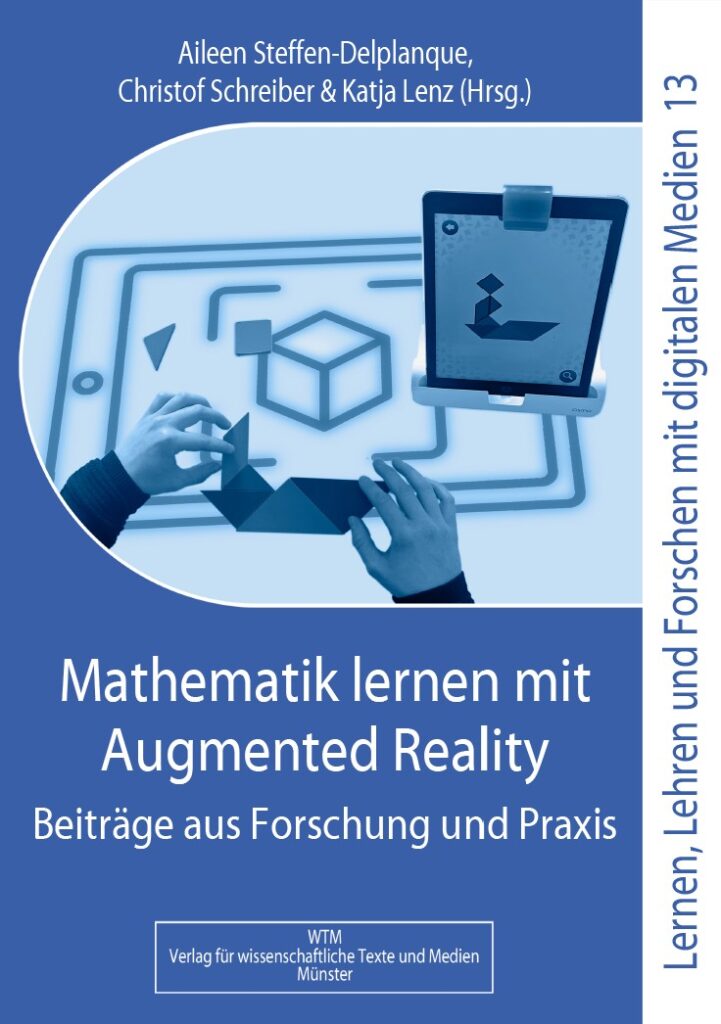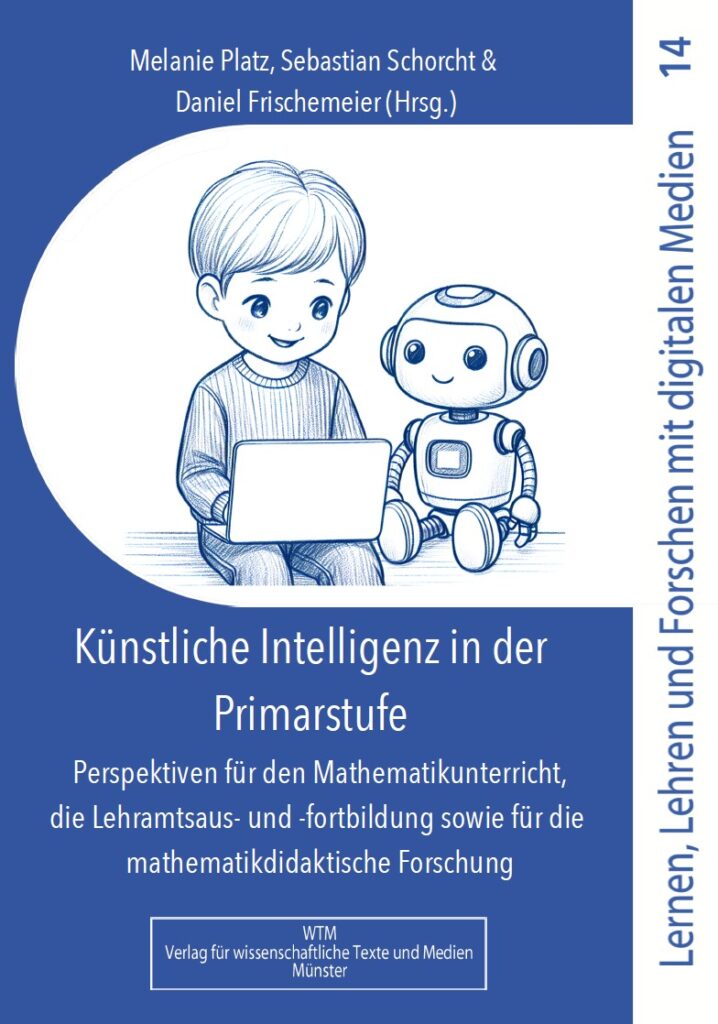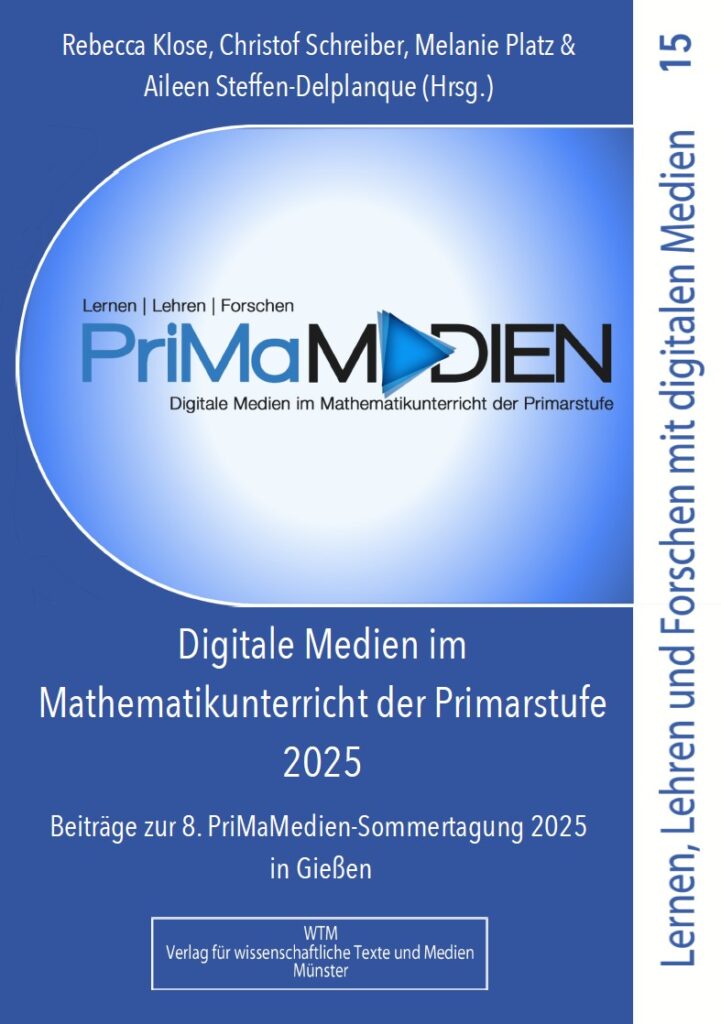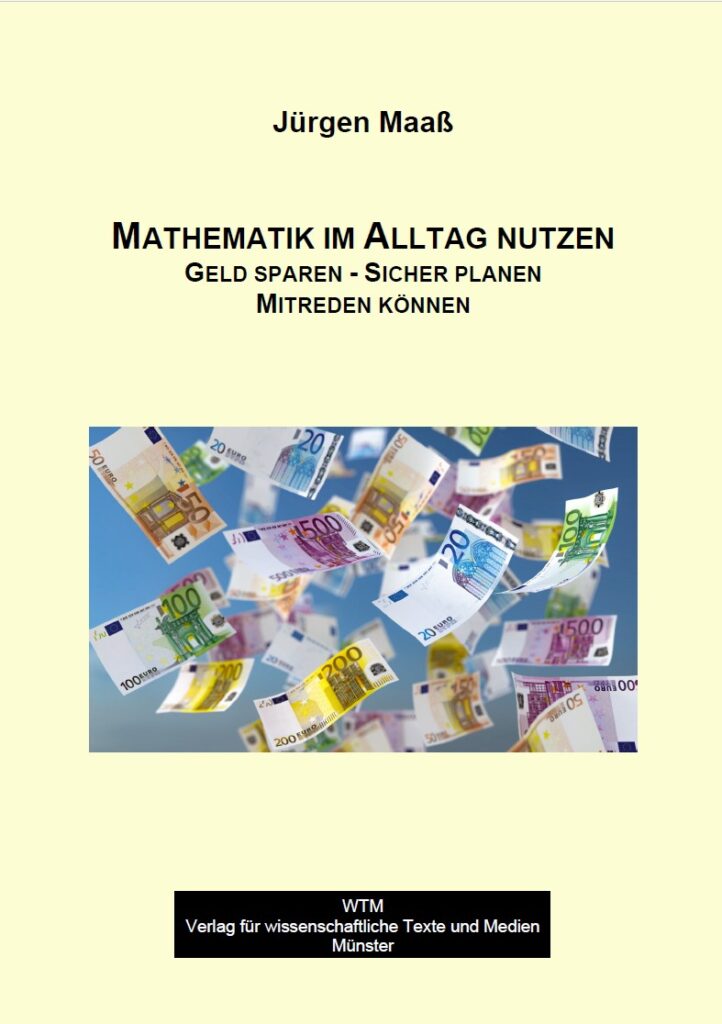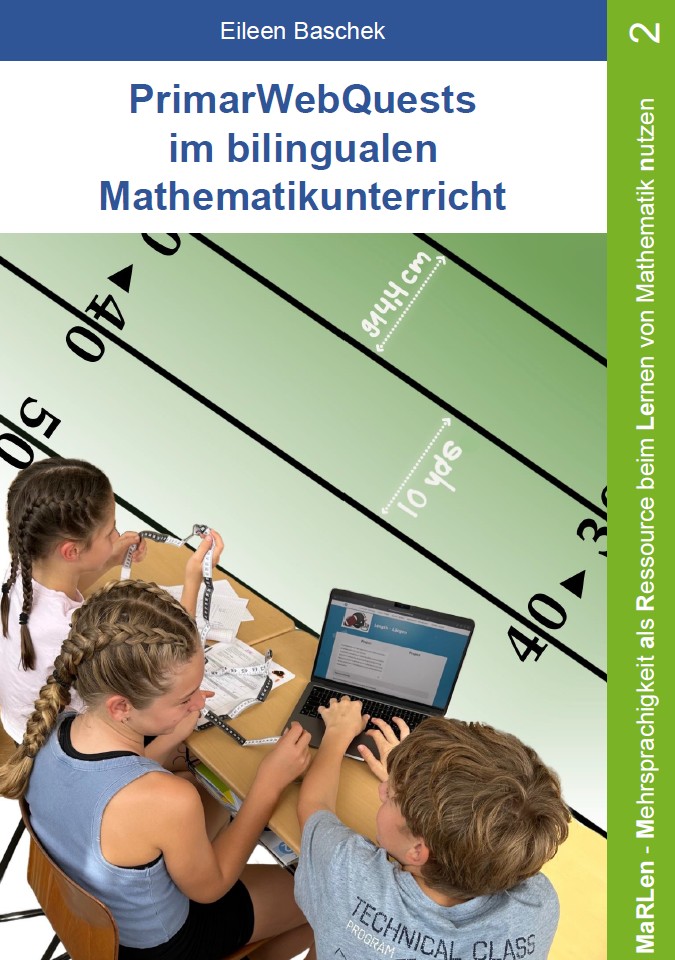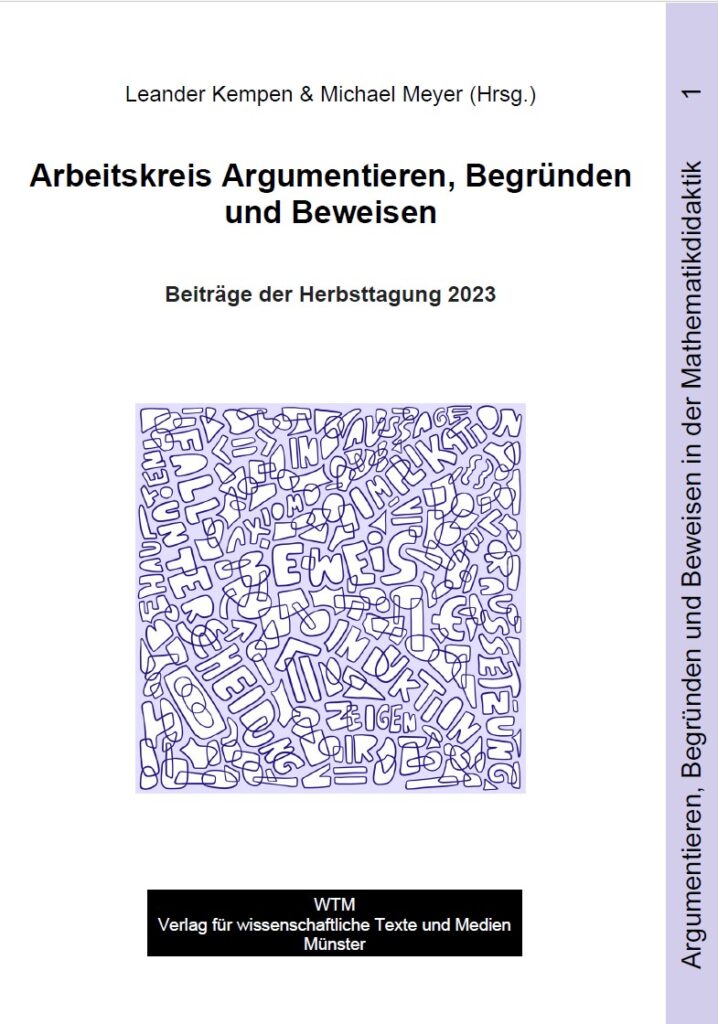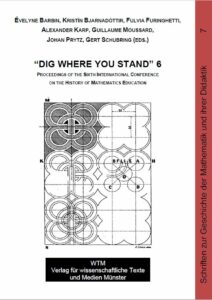 Proceedings of the Sixth International Conference on the History of Mathematics Education
Proceedings of the Sixth International Conference on the History of Mathematics Education
September 16-20, 2019, at the CIRM (Luminy), France
Münster: WTM-Verlag 2020.
Ca. 420, Seiten, DIN 17 cm x 24 cm
978-3-95987-167-9 Print 44,90 €
978-3-95987-168-6 E-book 40,90 €
https://doi.org/10.37626/GA9783959871686.0
Für Bestellungen bei edition-buchshop hier klicken
Click HERE for Shop-Page or mail to kontakt@wtm-verlag.de
The history of mathematics education is an interdisciplinary research area that is experiencing a significant development and this book presents recent work in this area. This book is the result of the sixth conference ICHME (In-ternational Conference on the History of Mathematics Education) that took place at CIRM, Luminy (France) from 16th to 20th of September 2019. Nowadays, the history of education is of the utmost importance for assessing the general development of the educational system(s) in which mathematics education occurs. Usually, the history of education is confined to history within a given civilization, country or nation. However, the quality of the research for a given nation is enhanced when situated among various specific cases, and comparative studies provide essential tools to broaden the perspectives to an international level. Moreover, mathematics, as a school discipline, has always functioned at the crossroads between general education and professional training, thus relating its teaching history to professional working environments as well. The themes dealt with in this book reflect this wide area of research. The book contains 28 chapters grouped in four parts concerning teaching of particular mathematical domains, teaching in cultural and national contexts, pedagogical movements and reforms, and methods of teaching.
======================
Johan Prytz: Algebra in Swedish mathematics curricula (1930-2000)
First Page: 1
Last Page: 14
https://doi.org/10.37626/GA9783959871686.0.01
Abstract
This paper can be seen as an overview concerning algebra in the Swedish mathematics curricula in the period of 1930-2000; the prescribed content of the algebra teaching is described and the basic ideas about how to teach algebra. The analysis is, however, focused on how the syllabi and commentary materials gave teachers more or less freedom to plan and carry out their teaching. The analysis is based on Basil Bernstein’s concepts of classification and framing.
======================
Hervé Renaud: Toward a rigorous teaching of calculus in France in secondary education (1885-1904)
First page: 15
Last page: 28
https://doi.org/10.37626/GA9783959871686.0.02
Abstract
In France, the period from 1887 to 1904 was decisive for the teaching of calculus in secondary education. Carefully introduced in 1851 into the curriculum of the school grades called classe de mathématiques spéciales which prepared for the entrance examination to the École polytechnique, the principles of calculus were still taught, in 1885, in an essentially intuitive way. The arithmetical foundations of calculus, mainly issued from the German School during the 1870s, were neither taught in secondary education nor in higher education, except at the École normale supérieure which trained teachers for secondary education. This article shows how teachers mainly graduated from this school introduced the teaching of these principles into the classe de mathématiques spéciales as well as into the lower levels of French secondary education outside the official curricula. Indeed, during that period, the first teaching of calculus was introduced into the curriculum of the baccalauréat, the final examination of French secondary education. Despite its rejection by the boards in charge of the curricula at the École polytechnique, a more rigorous teaching of calculus eventually ended up prevailing in the classe de mathématiques spéciales. The interactions between these school grades specific of the French secondary educational system and the lower levels contributed to the acceptance of this teaching.
======================
Sam Riley: Logarithms through their history in mathematics education
First page: 29
Last Page: 41
https://doi.org/10.37626/GA9783959871686.0.03
Abstract
Over the first century and a half of their discovery, logarithms were seen and understood in a variety of ways. Depending on the mathematical beliefs of an author, they could choose to introduce logarithms as a geometric-mechanical object, or as an index of a geometric progression, or through an exponential equation. The choice of introduction then influenced how their reader viewed and used logarithms, and has implications for teachers today as they attempt to explain this topic. In looking over the works of three authors, Colin MacLaurin, William Frend, and George Peacock, we can see logarithms displayed in three different ways. In combining these presentations with our modern understanding of logarithms as a number, an operation, and a function, we can choose parts of the text that could help current students make sense of a difficult concept.
Keywords: history, mathematicians, Cambridge, logarithms, textbook analysis
======================
Maria Cristina Araújo de Oliveira and José Manuel Matos: Shaping analytic geometry as a secondary school subject. A comparative study
First page: 43
Last Page: 56
https://doi.org/10.37626/GA9783959871686.0.04
Abstract
A comparative study exploring textbooks used in two distinct educational systems, Brazil and Portugal, was performed focusing on the ways in which analytic geometry was developed as a secondary school subject. Our analysis concentrates on textbooks from the late 19th century until the middle of the 20th century known to be used in schools.
Keywords: history, analytic geometry, textbooks, mathematics education
======================
Kei Kataoka: Descriptive geometry in middle school mathematics teaching in Japan (1905-1946)
First page: 57
Last Page: 72
https://doi.org/10.37626/GA9783959871686.0.05
Abstract
Teaching of descriptive geometry began in 18th-century France and became widespread in tertiary and secondary education worldwide throughout the 19th century. Until the 20th century, educators often described two aims of descriptive geometry – technical education and mathematics education. In Japan, descriptive geometry was introduced into engineering and artistic higher education after the Meiji Restoration of 1868. Descriptive geometry became part of the general secondary school curriculum in the 1880s, but it had been taught under the auspices of arts and crafts education rather than mathematics. In the early 20th century, Japanese mathematics educators began to focus on descriptive geometry as a way to reform solid geometry. When Japan’s secondary school curriculum was revised in 1942, descriptive geometry was included in solid geometry and mathematics for the first time. Although this curriculum lasted only until 1946, it was the fruit of many educators’ labors and is worthy of examination. This paper examines several books and documents from the early 20th-century Japan and shows that there was a technical, mathematics-oriented debate about the aim of descriptive geometry teaching as seen in Europe.
Keywords: descriptive geometry, solid geometry, secondary school, middle school, Nobutaro Nabeshima, Minoru Kuroda
======================
Kristín Bjarnadóttir: Royaumont’s aftermath in Iceland – Motion geometry, transformations and groups
First page: 73
Last Page: 86
https://doi.org/10.37626/GA9783959871686.0.06
Abstract
In the Meran Program in 1905 and at the Royaumont Seminar in 1959, among the main themes were transformation geometry, including motion geometry, and group theory. Those themes entered some Danish mathematics textbooks and the English School Mathematics Project’s textbook series, both used in Iceland around 1970. One of the arguments for including group theory in school mathematics was that its structure corresponded to structures in the minds of children. Eventually, the emphasis on motion in geometry subordinated the structure of the transformation groups. These ideas proved short-lived in Iceland, they coincided with a great expansion of the school system, students were unaccustomed to studying textbooks in English, available teachers were not receptive, and mathematical analysis was considered neglected. In later applications, geometric transformations have become the basis of a large industry: animations in motion pictures and games.
Keywords: motion geometry, transformation, group theory, School Mathematics Project
======================
Varvara Toura and Konstantinos Nikolantonakis: Presentation of the first probability textbook in the newly established Greek State
First page: 87
Last Page: 99
https://doi.org/10.37626/GA9783959871686.0.07
Abstract
The purpose of this paper is to present, describe and analyse the first book on probabilities in Greece, Elements of Probability Calculus and Theory of Errors, written by Periclis Rediadis as a process of dissemination of mathematical ideas from the “centre” (Europe) to the “periphery” (Greece). This article discusses the evolution of Probabilities in Modern Greek Education and investigates the author’s influences from probability books originating in France, Belgium and Germany. The first Greek textbooks mentioning Probability Theory are briefly presented (we focus mainly on the first three references to Probability, which were found in textbooks edited in 1888, 1893/1901 and 1908), and these findings are linked to external influences and internal peculiarities of the newly formed country. The article concludes with a general description of the oldest probability textbook published in the modern Greek state (1911) and it analyses of some indicative points in the last two chapters of the book, linking of each chapter’s content to previous manuals, Greek or foreign ones. The paper reflects the fact that the Calculus of Probabilities in Modern Greek Education arises not from pure mathematics but from teaching initiatives of technical education: Artillery, Topography and Experimental Physics compose the initial recruitment of the Probabilities at the turn of the 19th century. Furthermore, the first book was addressed to “the applied mathematical practitioners, officers, engineers, physicists, mathematicians, bankers, etc” as mentioned by the author on the cover page.
Keywords: history, education, modern Greek state, probability textbook
======================
Dominique Tournès: The teaching of graphical calculus in engineering schools (1860-1970)
First page: 101
Last Page: 114
https://doi.org/10.37626/GA9783959871686.0.08
Abstract
Graphical calculus is the part of numerical calculation that is based on geometrical constructions. It was established as a subject of knowledge and teaching from the 1860s onwards. With its three specialized components, graphical statics, graphical integration and nomography, it was a response to the growing calculation needs of engineers at the time of the industrial revolutions and the development of communication channels. It then became progressively obsolete in the 1960s due to the increasing role of computers and electronic calculators. The aim of the present contribution is to examine the content of graphical calculus courses created in engineering schools and universities between 1860 and 1960. Through a quantitative study of the treatises intended for the teaching of graphical calculus, we will also attempt to analyse, both chronologically and geographically, the diffusion processes of this teaching in Europe and the rest of the world during the period under consideration.
Keywords: history of mathematics, mathematics education, mathematics of engineers, graphical calculus, graphical statics, graphical integration, nomography.
======================
Alexander Karp: Highest mathematics: how mathematics was taught to future Russian tsars
First page: 115
Last Page: 128
https://doi.org/10.37626/GA9783959871686.0.09
Abstract
This paper attempts to describe the manner in which the grand dukes of Russia, including future emperors, were taught mathematics. The archives contain many unpublished and unstudied documents devoted to this matter. Such records inform us about the content and form of education and, more generally, of what actually took place in a school classroom at the time. Also of interest are the individuals invited to teach the tsars’ children. In a certain way, the selection of teachers gives us a sense of what was considered good in education. The discussion, which relies on unpublished archival materials as well as recently published ones and on memoirs that have been preserved, focuses on three generations -Nicholas I (1796-1855), his children, and his grandchildren, with brief excursuses into other periods.
Keywords: mathematics education, Russia, grand dukes, mathematics teachers, tutors.
======================
Ildar Safuanov: The history of Tatar mathematics education
First page: 129
Last Page: 142
https://doi.org/10.37626/GA9783959871686.0.10
Abstract
The history of mathematics education of the Tatar nation from Medieval to modern times is described. Three stages of the development of mathematical education in Tatar schools are traced: 1) Mathematical education in Arabic language (up to the last decades of the 19th century); 2) Mathematical education in old Turk-Tatar language with terminology mostly in Arabic (second half of 19th century and the beginning of 20th century); 3) Mathematical education in modern Tatar language (from the beginning of the 20th century, especially after the October revolution).
Keywords: history, mathematics education, Tatar language
======================
Jean-Paul Truc: Mathematical studies in the 18th century, in the work of François René de Chateaubriand
First page: 143
Last Page: 149
https://doi.org/10.37626/GA9783959871686.0.11
Abstract
In the 17th century, the youngest son of a noble family would follow a career as an officer in the army or as a priest. It is not surprising that Viscount François René de Chateaubriand (1768-1848) decided to prepare the exam to join l’École navale (Naval Academy), at that time École des gardes de la Marine. In fact, he did not decide this by himself, but followed the steps of his father, Count René-Auguste de Chateaubriand, ship-owner, navigator, and merchant. In this article, we will explore the book Mémoires d’outre tombe, following the young Chateaubriand in different schools, such as the Collège de Dol and the Collège de Rennes. At that time, the mathematician Étienne Bézout (1730-1783) was the almighty examiner for the entrance to l’École Navale. The memories of Chateaubriand introduce us to the way the scholars of the year 1780 studied their “Bézout” to improve their mathematical level.
Keywords: Naval Academy, Bézout
======================
Carène Guillet: Mathematics in the Bulletins de l’enseignement de l’AOF (French West Africa Education Bulletins) (1913-1958)
First page: 151
Last Page: 164
https://doi.org/10.37626/GA9783959871686.0.12
Abstract
The journal Bulletin de l’enseignement de l’Afrique occidentale française was created in 1913 by Georges Hardy, then director of colonial school for a year, to promote the cohesion of the teaching staff through a system of collaboration. The aim of this paper is to study mathematics teaching in the French West African school system between 1913 and 1958, as seen through this journal. First, this paper will examine the place of mathematics in the African school system, both in importance and level, to compare it with the one of Metropolitan France. In particular, the examination test statements will be studied, and their level will be compared to the Metropolitan French ones. More qualitatively, we will look at impressions expressed by some authors on the level of students and teachers in West Africa. Then, we will focus on the official recommendations of the institutions concerning the content taught, the pedagogical methods and the resources. Among that, it is necessary to analyse the role of the European educational trends of the time (method of “the centers of interest”, Freinet or Montessori’s methods and “active pedagogy”) in the colonies. Finally, practices on the ground will be watched: the observation of the environment and the local population, the possible adaptation of teaching to the specificity of the territory and its inhabitants, and the various experimentations reported in the periodical. We will be careful to Hardy’s ambition to see the birth of an “indigenous pedagogy”. This study is a way for us to travel through periods, personalities, and texts, just through reading magazines and staying on French soil. It is also an opportunity to see an example of how mathematics education has been impacted by a very particular historical and sociological context.
Keywords: mathematics education, French West Africa, indigenous pedagogy, official instructions, curricula, classroom experiences, level
======================
Ezzaim Laabid: Textbooks using mathematics in the margins of current mathematics: manuals for teaching inheritance in Morocco
First page: 165
Last Page: 176
https://doi.org/10.37626/GA9783959871686.0.13
Abstract
Nowadays in Morocco, the distribution of inheritance is part of the basic juridical-religious curriculum taught in high school and in some branches of humanities and social sciences in higher education. This question of inheritance is, in fact, a taught discipline – called cilm al-farā’iḍ (lit. science of prescriptions) – with its own textbooks and its own teachers. In their presentation of the mathematical aspect related to this question of inheritance, these textbooks implement mathematics which uses a language and a vocabulary specific and different from those conveyed in modern mathematical teaching. In this paper we try to shed some light on this mathematical practice and highlight some of its peculiarities. For this, we present some textbooks for the teaching of this discipline by focusing on their mathematical content. We will also highlight the basic features of mathematics conveyed by these textbooks and their differences with current mathematics.
Keywords: Inheritance problems, vocabulary, fraction, resolution process, manuals.
======================
Mahdi Abdeljaouad and Pierre Ageron: Sulaymân al-Harâ’irî (1824-1877): his attempts to reconcile the Islamic civilization with modern science and mathematics education
First page: 177
Last Page: 191
https://doi.org/10.37626/GA9783959871686.0.14
Abstract
Who was Sulaymân al-Harâ’irî? Little is known about this enigmatic and controversial scholar. Born in Tunis in 1824, he settled in Paris in 1856 and died there in 1877. His unpublished manuscripts contain many translations into Arabic of French books, several of which are pertinent to mathematics. He translated arithmetic textbooks by Hippolyte Vernier, a surveying textbook by G. Frédéric Olivier and La Lande’s survey on uses of logarithms. He also drew up the plan for a comprehensive treatise on practical geometry, thus apparently laying the foundation for a Euro-Islamic hybrid mathematical knowledge.
Keywords: Tunisia, Arabic language, translation, hybridization, arithmetic, logarithms, practical geometry
======================
Sian Zelbo: Edgar J. Edmunds (1851-1887): A crosscultural case study of an African American mathematics teacher who studied at the École polytechnique
First page: 193
Last Page: 204
https://doi.org/10.37626/GA9783959871686.0.15
Abstract
The late 19th century was a period of significant change in American mathematics education as the country started to open up to the advancements of continental Europe. At this time, mathematics departments at American universities began to look to European universities for inspiration, and American textbook authors began to incorporate European advances in mathematical content and pedagogy. Edgar Joseph Edmunds was a mathematics teacher who studied in France and taught in America at the dawn of this period of awakening and cultural exchange, and a study of his life and career gives new insight into this important period.
======================
Karolina Karpińska: Scientific novelties implemented into teaching mathematics in secondary schools on the Polish territories in the 19th century. The case of descriptive geometry
First page: 205
Last Page: 218
https://doi.org/10.37626/GA9783959871686.0.16
Abstract
This article is dedicated to discussing the implementation of the descriptive geometry, i.e. the scientific novelty from the end of the 18th century, in secondary school education on the Polish territories in the 19th century. At that time, Polish lands were under the occupation of three empires: Prussia, Austria, and Russia. Over the time, the policy of the partition empires toward the Poles was changing in intensity. As a consequence, in the 19th century, there were schools on the Polish territories with Polish, Prussian, Austrian and Russian curricula and relevant lecture languages. The article analyses the implementation of descriptive geometry into teaching mathematics in schools located in all three partitions.
Keywords: descriptive geometry, history of mathematics education, history of mathematics
======================
Évelyne Barbin: From experimental to theoretical geometry in new pedagogical movements at the turn of the 19th and 20th centuries (1872-1906)
First page: 219
Last Page: 232
https://doi.org/10.37626/GA9783959871686.0.17
Abstract
There exist many historical works on the new pedagogical movements in the beginning of the 20th century, at the level of one country and at the international level also. Our purpose is to focus on teaching of geometry with comparing situations in four countries: United Kingdom, France, Germany and United States. We show that, behind the agreements, there are deep differences in relation with questions posed by geometrical teaching. We use two kinds of materials, discussions and textbooks, and we specially examine the questions on parallels definitions and their introduction in teaching.
Keywords: laboratory method, concrete geometry, experimental geometry, intuitive geometry, practical geometry, rational geometry, Émile Borel, Carlo Bourlet, John Dewey, George Halsted, Julius Henrici, Adelia Hornbrook, Jules Houël, Charles Méray, Eliakim Moore, John Perry, Peter Treutlein.
======================
Circe Mary Silva da Silva and Maria Célia Leme da Silva: Intuitive and experimental geometry: circulation of international proposals
First page: 233
Last Page: 246
https://doi.org/10.37626/GA9783959871686.0.18
Abstract
The late 19th and early 20th centuries are marked by the international circulation of new methodologies for the teaching of geometry. The aim of the present study is to analyze geometry and pedagogy textbooks for elementary education which circulated in countries such as France, Germany, the United States and Brazil. The paper seeks to answer the question: what are the supporting pillars for the formulation of an intuitive and experimental geometry read in the different textbooks? The circulation and appropriations of various protagonists are identified in search of the production of an intuitive and modernizing geometry, in contrast to the abstract, deductive and logical character of Euclidean geometry.
======================
Fulvia Furinghetti, Livia Giacardi and Marta Menghini: Actors in the changes of ICMI: Heinrich
Behnke and Hans Freudenthal
First page: 247
Last Page: 260
https://doi.org/10.37626/GA9783959871686.0.19
Abstract
The years after WWII up to the late 1960s were crucial in the evolution of ICMI (International Commission on Mathematical Instruction) for both the settlement of some institutional aspects (mainly concerning the relationship with mathematicians) and the establishment of new trends of the activities. By referring to unpublished documents, this paper focuses on the role of two key figures in those years: Heinrich Behnke and Hans Freudenthal. As ICMI Secretary and later as President, Behnke tried to reshape the newborn ICMI after WWII and clarify the relationship with mathematicians. His action was completed by Freudenthal, who, as ICMI President, broke with the past and promoted initiatives that fostered the development of mathematics education as an academic field and the independence of ICMI from the community of mathematicians.
Keywords: history, ICMI, mathematicians, mathematics education
======================
René Guitart: Metamorphosis of geometrical teaching in France (1950-1969)
First page: 261
Last Page: 274
https://doi.org/10.37626/GA9783959871686.0.20
Abstract
The “metamorphosis” can be explained quickly as follows: it is the replacement in teaching of geometrical proofs using inspection of classical figures as segments, triangles, conics, with geometrical transformations and also algebraic calculations, by the exclusive use of calculations in linear algebra with matrices. The visual aspect in the geometric sense disappears in favor of algebraic calculation alone. The back and forth between figures and calculations are forgotten but the capacity of calculations increases.
My purpose is only to provide some clarifications about the sources and conditions of such a metamorphosis in France. When and how the organization of changes of geometrical teaching had been thought? Two precautions are necessary: a distinction must be made between teaching in secondary level (students aged 14 to 18) and in tertiary level (students at the university); and this must be examined especially before the “Réforme des mathématiques modernes” [new maths]. I show that, in fact, events started almost ten years before the meeting at Royaumont in 1959, with Gustave Choquet as one of the main actors. He tried to introduce a modern teaching, with linear structures (the “royal road”), but at the same time he wanted to preserve the geometrical intuition given by experience with real objects, with several “intuitive” axiomatics. At the end, the Reform did not take this moderate direction, and it was Jean Dieudonné’s purely linear approach that was privileged, up to excess of formalizations and calculations. Hence the metamorphosis arrived, when the view of the figures was replaced by the view of equations, and worse by formalization. As a testimony I explain how under these circumstances I learned geometry in the 1960s and taught geometry at the early 1970s at the university of Paris 7.
Keywords: reform of modern mathematics, geometry, teaching, France, APMEP, CIEAEM, Gustave Choquet, Jean Dieudonné, Lucienne Félix, Caleb Gattegno, Morris Kline, Georges Papy, Jean Piaget, André Revuz, Gilbert Walusinski
======================
Ysette Weiss: Back to the future – a journey from current education reforms to reformations in the past
First page: 275
Last Page: 288
https://doi.org/10.37626/GA9783959871686.0.21
Abstract
Learning from history does not automatically mean that history prevents us from repeating mistakes. We cannot see what happens in the future, even with the most profound knowledge of the past. Although it is not possible to make such causal connections, the study of structural components, which recur and make up patterns, can certainly contribute to sharpening political judgement. How can the teaching of the history of mathematics education then help to support an understanding of possible courses of individual actions without indoctrination through the political or even ideologically influenced production of time references? The paper presents the concept of a lecture course in mathematics education, held at the University of Mainz. We take as a point of departure the everyday experience of our prospective mathematics teacher with various current education reforms and present seemingly similar processes during former reforms. Here we limit ourselves to reforms during the 19th and 20th century.
======================
Gert Schubring: The development of forms for studying Mathematics
First page: 289
Last Page: 302
https://doi.org/10.37626/GA9783959871686.0.22
Abstract
There is a widespread conviction that institutionalised forms for studying mathematics, such that persons studying mathematics would obtain a degree and have access to a professional career, have always existed. A closer look reveals, however, that for Antiquity and for the Middle Ages, studying mathematics was essentially a solitary undertaking by a few individuals dispersed in space and time; and none of them was able to dedicate himself entirely to mathematics – typically, these few scientists were polymaths.
Investigating the issue has thus been focussed on Modern Times, and then for a long time on Western Europe. Yet, it was only with the establishment of systems of public education in the wake of the French Revolution that study courses leading to degrees emerged – the long process of their development with its many facets and differences in different cultures and states has not yet been studied comprehensively. There are a number of studies on some aspects of these processes, but these do not relate them to a general analysis. This paper aims at elaborating such a general analysis.
======================
Michael Friedman: Friedrich Fröbel’s conception of crystallography and the mathematical education at the 19th century kindergartens
First page: 303
Last Page: 316
https://doi.org/10.37626/GA9783959871686.0.23
Abstract
What is the connection between crystallography and kindergarten activities? The paper aims to show the ways Friedrich Fröbel, the founder of the modern kindergarten, was influenced by crystallography at the beginning of the 19th century. This influence explicitly manifested itself not only in a transfer of concepts from the German crystallographer Weiss, but also in a transfer of images, whose source was the French crystallographer Haüy. Fröbel, having a peculiar conception of mathematics, reshaped concepts and images from crystallography already during the 1810s, and conceptualized his playful objects with them for children.
Keywords: Crystallography, Mathematics at the 19th century kindergartens, Friedrich Fröbel, René-Just Haüy, Christian Samuel Weiss.
======================
Lisa Rougetet: The pedagogical aim of recreational mathematics’ mechanical puzzles at the end of the 19th century in France
First page: 317
Last Page: 330
https://doi.org/10.37626/GA9783959871686.0.24
Abstract
This contribution is presented within the scope of a historical reflection on the place and the role of recreational mathematics in mathematics education at the end of the 19th century in France, focusing on a specific form of mathematical recreation: the Baguenaudier. The history of this mechanical puzzle, along with its resolution through mathematical tools – in particular the binary system –, reveals the pedagogical interests of the use of mathematical recreations in education. This last aspect was fully accepted in France in the 1880s, for instance with the French mathematician and author of mathematical recreations Édouard Lucas who highlighted the relevance of certain scientific games to teach and practice arithmetic.
Keywords: recreational mathematics, Baguenaudier, 19th century France, binary system
======================
Yannick Vincent: Giving a Conférence at the École Polytechnique at the end of the 19th century
First page: 331
Last Page: 341
https://doi.org/10.37626/GA9783959871686.0.25
Abstract
During the 19th century, training at École polytechnique was divided between courses in the lecture hall and studying in smaller rooms. At the end of the century, the school decided to set up some additional Conférences as it existed in other institutions. The purpose of this paper is to explain what the goals of the teachers who gave these Conférences were. To this end, we shall focus on debates in the Teaching Committee of the school and on the content of the Conférences according to reports in the archives of the École polytechnique.
Keywords: history of teaching, France, École polytechnique, 19th century.
======================
Maria Giuseppina Adesso, Roberto Capone, Oriana Fiore and Francesco Saverio Tortoriello: Walking through the history of geometry teaching by Cevian and orthic triangles and quadrilaterals
First page: 343
Last Page: 354
https://doi.org/10.37626/GA9783959871686.0.26
Abstract
The history of geometry teaching in Italy, in the period from the final years of the 19th century to the first half of the 20th century, is analysed here, taking into account the influence of both school reforms and the “New geometry of the triangle”, first introduced in France in 1873. Specifically, we refer to some theorems, about Cevian and orthic triangles, which may be included in the “New geometry of the triangle”, although they have been discovered in Italy before 1873. Some Italian booklets and textbooks have been analysed, to show the influence of these factors on the geometric teaching.
Keywords: geometry teaching, New geometry of the triangle, Ceva’s theorem, orthic triangles, Cevian quadrilaterals, Fagnano’s problem.
======================
Dirk De Bock: Georges Cuisenaire’s numbers in colour. A teaching aid that survived the 1950s
First page: 355
Last Page: 368
https://doi.org/10.37626/GA9783959871686.0.27
Abstract
In 1952, a Belgian primary school teacher, Georges Cuisenaire, published Les nombres en couleurs, a booklet in which the author describes his invention and explains a corresponding method for teaching elementary arithmetic. Cuisenaire materialized the numbers from one to ten by means of rods of corresponding lengths and in different colours. The rods provided a concrete tool for exploring and gaining insight in basic concepts and skills, such as the four basic operations, finding divisors and multiples, working with fractions, the decimal system, arithmetic sequences, and area and volume calculation. From the mid-1950s, with the support of Caleb Gattegno, the Cuisenaire rods broke through worldwide. In subsequent years, empirical research into the effectiveness of the Cuisenaire’s method was initiated and in several countries Cuisenaire Associations were founded. In the late 1960s and 1970s, a number of attempts were made to use the material for the teaching of typical modern mathematics contents to (very) young children, but the use of the rods in this context was sometimes far-fetched and did not break through.
Keywords: CIEAEM, Cuisenaire rods, numbers in colour, teaching aid, teaching material, Georges Cuisenaire, Caleb Gattegno
======================
Jörg Zender: On the history of mathematics trails
First page: 369
Last Page: 382
https://doi.org/10.37626/GA9783959871686.0.28
Abstract
Mathematics trails have been in use for more than 40 years. A special outdoor learning environment that provides us interesting insides in the dissemination of such new forms of learning through its history. Both ways of dissemination can be found. We will first have a look at the steady development through a community of practitioners in the United Kingdom. The second way is the fast dissemination through a single multiplier, starting with Dudley Blane in Australia. In addition, the evolving variety of ways to do a mathematics trail is also part of this article.
Keywords: mathematics trails, ICMI, mathematics education, history, outdoor education
